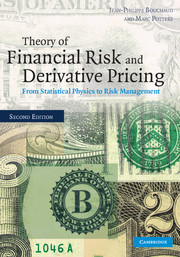Book contents
- Frontmatter
- Contents
- Foreword
- Preface
- 1 Probability theory: basic notions
- 2 Maximum and addition of random variables
- 3 Continuous time limit, Ito calculus and path integrals
- 4 Analysis of empirical data
- 5 Financial products and financial markets
- 6 Statistics of real prices: basic results
- 7 Non-linear correlations and volatility fluctuations
- 8 Skewness and price-volatility correlations
- 9 Cross-correlations
- 10 Risk measures
- 11 Extreme correlations and variety
- 12 Optimal portfolios
- 13 Futures and options: fundamental concepts
- 14 Options: hedging and residual risk
- 15 Options: the role of drift and correlations
- 16 Options: the Black and Scholes model
- 17 Options: some more specific problems
- 18 Options: minimum variance Monte–Carlo
- 19 The yield curve
- 20 Simple mechanisms for anomalous price statistics
- Index of most important symbols
- Index
18 - Options: minimum variance Monte–Carlo
Published online by Cambridge University Press: 06 July 2010
- Frontmatter
- Contents
- Foreword
- Preface
- 1 Probability theory: basic notions
- 2 Maximum and addition of random variables
- 3 Continuous time limit, Ito calculus and path integrals
- 4 Analysis of empirical data
- 5 Financial products and financial markets
- 6 Statistics of real prices: basic results
- 7 Non-linear correlations and volatility fluctuations
- 8 Skewness and price-volatility correlations
- 9 Cross-correlations
- 10 Risk measures
- 11 Extreme correlations and variety
- 12 Optimal portfolios
- 13 Futures and options: fundamental concepts
- 14 Options: hedging and residual risk
- 15 Options: the role of drift and correlations
- 16 Options: the Black and Scholes model
- 17 Options: some more specific problems
- 18 Options: minimum variance Monte–Carlo
- 19 The yield curve
- 20 Simple mechanisms for anomalous price statistics
- Index of most important symbols
- Index
Summary
If uncertain, randomize!
(Mark Kac)Plain Monte-Carlo
Motivation and basic principle
The calculation of the price of options can only be done analytically in some very special cases: the statistics of the underlying contract must be ‘simple enough’ (for example, the Black-Scholes log-normal process), and the option contract itself must not be too ‘exotic’. For example, ‘American’ options, that can be exercised at any time, cannot be priced exactly, even in the simple framework of the Black-Scholes model.
On the other hand, as emphasized throughout this book, the fluctuations of the underlying assets are in general non-Gaussian, with complex volatility-volatility and return-volatility correlations. Furthermore, real world options often involve clauses that are difficult to deal with analytically. It can therefore be compulsory to rely on numerical methods to price and hedge these options. Aversatile and commonly used method is the Monte-Carlo method, that we first explain in the context of ‘plain vanilla’ European options. Suppose that the interest rate r is zero, and that one chooses to Δ-hedge the option. In this case, the price of the option today is equal to the average pay-off of the option, over the detrended distribution of price returns (this price is called the ‘risk-neutral’ price, see the discussion in Section 15.2.2).
The most naive method to compute the option price would be to generate an ensemble of paths according to a certain (zero-drift) stochastic model, and to compute the average pay-off over this ensemble.
Information
- Type
- Chapter
- Information
- Theory of Financial Risk and Derivative PricingFrom Statistical Physics to Risk Management, pp. 317 - 333Publisher: Cambridge University PressPrint publication year: 2003
